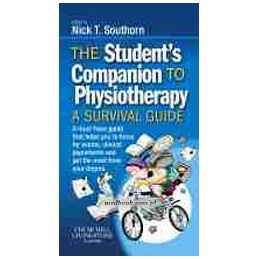- Reduced price

Order to parcel locker

easy pay


 Delivery policy
Delivery policy
Choose Paczkomat Inpost, Orlen Paczka, DHL, DPD or Poczta Polska. Click for more details
 Security policy
Security policy
Pay with a quick bank transfer, payment card or cash on delivery. Click for more details
 Return policy
Return policy
If you are a consumer, you can return the goods within 14 days. Click for more details
Data sheet
Contributors Acknowledgements Editor s introduction An introduction by Professor the Baroness Finlay of Llandaff, MD, FRCP
SECTION 1 SETTLING IN Chapter 1 In the beginning Nick Southorn and Jamie Mackler Day one What is physiotherapy? A brief history of physiotherapy Physiotherapists at work International organizations Swatting up Books to buy Equipment Freshers week Study tips Being a member of the representative body of physiotherapy
Chapter 2 Things I wish theyd told me before I started Stuart Porter What am I letting myself in for? Not sure I deserve to be here What is different about studying at degree level? The language of the university How to conduct yourself What your lecturers expect from you How do I get through the first year? What you should expect from your lecturers How to get through your exams Finally
SECTION 2 STUDYING PHYSIOTHERAPY Chapter 3 Anatomy and physiology Nick Southorn Introduction - anatomy Visualizing anatomy Mnemonics and chants Introduction - physiology Learning physiology Tool box In the clinic Conclusion
Chapter 4 Musculoskeletal physiotherapy Nick Southorn So what is musculoskeletal therapy? Initial subjective assessment Initial objective assessment Clinical semaphore Treatments Maitland Cyriax/orthopedic medicine McKenzie Acupuncture Muscle energy techniques Myofascial therapy Pilates Exercise therapy Massage In the clinic
Chapter 5 Electrotherapy Tim Watson What is it? Why is it important? Useful ways to study Resources and information
Chapter 6 Cardiopulmonary physiotherapy Mandy Jones Learning the theory Tips for learning anatomy Tips for learning physiology Tips for learning physiotherapy Preparation for clinical placement Tips for clinical placement Hazards of clinical placement Conclusion
Chapter 7 Neurologic physiotherapy Nick Southorn What you need to know Basics Conditions Assessment Treatment of the neurologic patient In the clinic
Chapter 8 Pharmacology Nick Southorn How do I get my head around all of this? Its all about class! What do I need to know about these drugs? In the clinic Conclusion
Chapter 9 Biopsychosocial approach Paul Watson Why a biopsychosocial perspective? A biopsychosocial model of pain disability So what are the important things to consider? In the clinic Integrating assessment into practice Conclusion
Chapter 10 Pediatrics Nick Southorn Be a child, it helps! Childhood diseases How to assess a child patient Subjective assessment Objective assessment Treatments Conclusion
Chapter 11 Clinical placement Nick Southorn How to prepare What you need to know before you get there Uniform etiquette What you need to know when you get there The learning agreement Marking criteria The role of the clinical educator The role of the academic tutor Conclusion
SECTION 3 THE FINAL STRETCH Chapter 12 Clinical audit and research Herbert Thurston Clinical audit Research Types of research Getting started in research Real-life researchers
Chapter 13 The degree continues Nick Southorn and Nick Clode Professional practice Evidence-based practice Portfolio development What is a CPD portfolio? Why do I need to keep a CPD portfolio? What does a portfolio look like? What should it contain? Portfolio keeping - what you need to know Online versus paper-based portfolio systems Steps in setting up a CPD portfolio Finally Reflection
Chapter 14 You think its all over . Nick Southorn and Nick Clode Results What to do with your textbooks Opportunities for the graduate Looking for jobs in the UK Websites Recruitment agencies Interviews Interview format Preparation Interview tips Appearance On the day Conclusion
